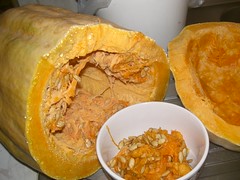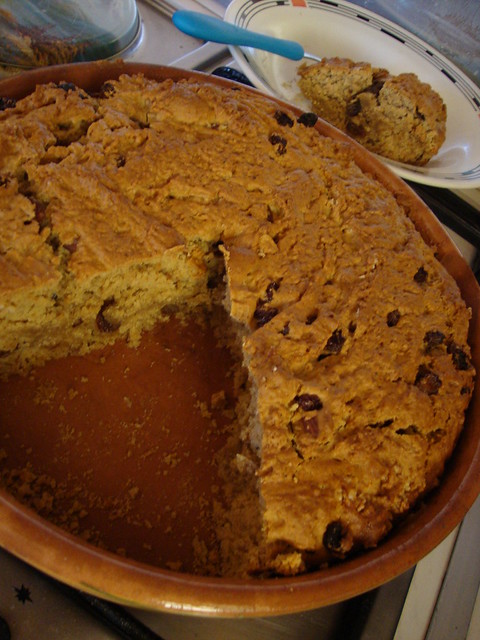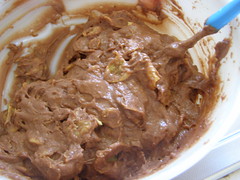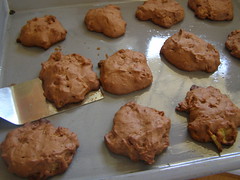 Pumpkin has never been hugely popular in Crete. It doesn't have the fame here that it does in Northern Greece, or the American continent, where cooking with pumpkin is a common feature of the respective cuisines found in each area. I'm often lucky to be given one, but this year, that hasn't happened. I think it's related to the reason why we didn't find any quince on our trees, while all the bitter oranges that I usually make into a spoon sweet have also disappeared. Times are hard, and pumpkin now tastes good...
Pumpkin has never been hugely popular in Crete. It doesn't have the fame here that it does in Northern Greece, or the American continent, where cooking with pumpkin is a common feature of the respective cuisines found in each area. I'm often lucky to be given one, but this year, that hasn't happened. I think it's related to the reason why we didn't find any quince on our trees, while all the bitter oranges that I usually make into a spoon sweet have also disappeared. Times are hard, and pumpkin now tastes good...I still like to cook with at least one pumpkin every autumn because it's part of the seasonal nature of my cooking regime. Pumpkin is also very versatile, meaning that you can make it into any kind of meal you like, both sweet and savoury, both pie and soup. The one I bought wasn't too expensive - 2 kilos for 2.50 euro. My friend Demetra recommended a recipe that her sister had given her. She called it a pumpkin bougatsa, and told me it was one of the most amazing pies she had ever had. Bougatsa is a kind of cheesy/milky pastry pie, served all over Northern Greece; in Crete, it has its own variant, notably, bougatsa Iordanis.
 OK, I told her, I'm interested in giving it a try. She then insisted once again that it was the best pumpkin pie that she had ever made or tasted. Interestingly, when she passed on the recipe to me, there was no photo showing the cooked dish. Most people look at food photos on the internet or in a book and cook from the accompanying recipes, using the photos as a gauge to what they should expect.
OK, I told her, I'm interested in giving it a try. She then insisted once again that it was the best pumpkin pie that she had ever made or tasted. Interestingly, when she passed on the recipe to me, there was no photo showing the cooked dish. Most people look at food photos on the internet or in a book and cook from the accompanying recipes, using the photos as a gauge to what they should expect.Sometimes, though, you chance on a recipe that you know will be good from the way the recipe is written. It isn't often the case at all, but I was convinced that this pumpkin bougatsa would turn out to be a good one, despite its simple ingredients, from some of Demetra's instructions:
You can tell the writer actually made this recipe, and enjoyed the whole process, not just the food. I asked Demetra about the origin of the recipe: her sister came across it at a women's monastery near Montreal in Canada. Apparently, the nuns serve it to guests in the afternoon on a regular basis. The recipe has made its way from Canada to Boston to NYC to Athens, and now to Crete!
When Demetra visited her sister recently, they cooked a lot together. Just before Demetra was due to leave, her sister "absol
 As I was making the bougatsa myself (with home-made filo pastry of course!), I realised that the same pastry and filling, layered in a slightly different manner, could easily make two different kinds of Greek pita: bougatsa, and galaktoboureko. Each pita is served in its own unique way. And you don't have to choose which one to make before it goes into the oven - you can do that while it's cooking!!! I halved the recipe because the original made a very large pie. Even then, I was still able to make both kinds of pita in the same cooking session.
As I was making the bougatsa myself (with home-made filo pastry of course!), I realised that the same pastry and filling, layered in a slightly different manner, could easily make two different kinds of Greek pita: bougatsa, and galaktoboureko. Each pita is served in its own unique way. And you don't have to choose which one to make before it goes into the oven - you can do that while it's cooking!!! I halved the recipe because the original made a very large pie. Even then, I was still able to make both kinds of pita in the same cooking session.
I had to juggle between the stove and making my own filo pastry. To prevent it from drying out, I dustead each sheet with cornstarch, then folded it in half, and then in half again. I put the sheets aside until the filling was ready.
To make Demetra's sister's basic Greek-based pumpkin pita, you need:
2-3 cups cooked mashed pumpkin
2 cups milk (or 1 cup cream mixed with 1 cup water, which is what I used)
1/2-3/4 cup sugar
3 eggs
5 tablespoons of flour
some vanilla flavouring (I use vanilla essence in liquid form; there are many different ways that vanilla flavouring is sold, including vials and sachets of vanilla-flavoured sugar)
1 tablespoon of butter (I always use olive oil these days)
a packet of filo pastry (these days, I make my own filo - no, it's NOT that difficult!)



The recipe above is enough to make both pies. I layered the larger pie (which I turned into a galaktoboureko), by lining the ceramic dish with three sheets of pastry, then a thin layer of filling, then another two sheets of pastry and some more filling, and finally another three sheets of pastry on the top. For the smaller pie (which became bougatsa), I laid two sheets of pastry on the bottom of the tin, the remaining filling, and another two sheets of filo on the top, oiling all the filo.


Put aside 1/2 cup of pumpkin and heat the remaining with the milk and sugar. (As Demetra says, it will be a gorgeous orange colour - enjoy it.) In a bowl, mix the eggs, flour and vanilla, then add the remaining pumpkin, and mix well. Pour the egg mixture into the milk mixture and mix quickly. Don't worry if the mixture curdles (make sure the milk mixture isn't too warm and the egg mixture isn't too cold).
Now listen to Demetra: "Keep on low heat to thicken. Stir...stir here and there... don’t let it stick on the bottom of the pan.....stir... clean your kitchen.....stir occasionally....stir.....enjoy gorgeous color and aroma....and once it becomes thick, take it off the burner and add the butter. (You will not have to stir non-stop if the heat is correct; just stir from time to time, keeping an eye on the heat so the mixture doesn’t stick to the bottom of the pan.)" At this point, taste a little of the mixture (watch out - it may burn): you could easily eat it before it becomes a pie...
Grease a pyrex dish or baking tin and lay half the filo pastry sheets on the bottom, greasing in between each layer. Then pour in the filling, which may look runny, but don't worry about that because it will eventually cook like a custard. Then layer the remaining filo sheets on top - don't forget to grease each one! Fold the overhanging pastry, greasing them too.

Pumpkin bougatsa
If you turn your pita into a pumpkin bougatsa, you only need some sugar and/or cinamon for sprinkling over it (or none at all, depending on how sweet you like your pita to be). Bougatsa is served warm, and can be re-heated the next day. It makes an especially delicious breakfast meal.

Pumpkin galaktoboureko
I'm posting this recipe in time for American Thanksgiving for a pumpkin pie idea. If you're celebrating Thanksgiving in Greece, this is the pita that will make this year's feast a memorable one. If you're celebrating Thanksgiving in America, this pita marries Greek cuisine with the American feast. Even though I don't celebrate Thanksgiving here in Greece, I have plenty to be thankful for, not least of which includes the availability of high quality cheap food. If you make your own filo, both the above pies will cost you less than 5 euro to make in total.
©All Rights Reserved/Organically cooked. No part of this blog may be reproduced and/or copied by any means without prior consent from Maria Verivaki.





